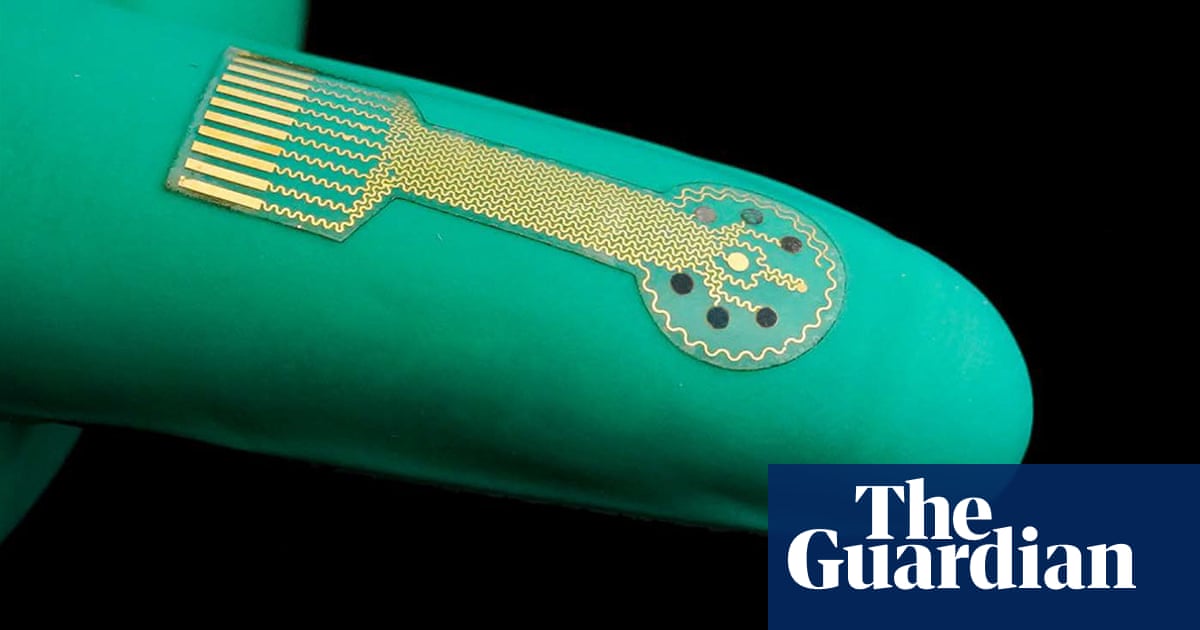
A smart bandage that can monitor chronic wounds and help them to heal has been developed by scientists who say the device could aid people with diabetic ulcers, burns and non-healing surgical wounds.
According to figures from 2018, there are 2.2 million people in the UK with chronic wounds, costing the NHS £5.3bn a year.
Now researchers say they have come up with a device that could help such wounds heal: a stretchable, wireless, bioelectronic system that can stick to the skin.
“The device consists of two parts – one reusable flexible printed circuit board and one disposable patch,” said Dr Wei Gao, a co-author of the research from the California Institute of Technology. “The disposable patch contains biosensors, electrodes, and drug-loaded hydrogels.”
The biosensors mean the “smart bandage” device can monitor features of the wound such as its temperature, pH, and levels of substances including glucose, uric acid and lactate – metrics that provide important insights into whether the wound is infected and its levels of inflammation.
The device allows for electrical stimulation to be applied – a technique previously found to encourage wounds to heal, but which has been hampered by bulky equipment. It also enables the controlled released of anti-inflammatory and antimicrobial drugs.
“All the signals can be wirelessly sent to a user interface [such as] a computer or a cellphone,” said Gao. “We can wirelessly control the drug release by applying electrical potential.”
Writing in the journal Science Advances, the team describe how they tested the smart bandages on wounds of diabetic mice and rats before and after infection, finding the devices were able to detect features including the temperature, glucose levels and pH of the wound fluid. These measurements changed as expected before and after the mice were given treatment.
What is more, mice with smart bandages who experienced both drug release and electrical stimulation showed higher rates of wound closure and less scarring than mice whose wounds were not covered by the bandages.
The team say they expect costs at the level of tens of dollars for the reusable electronics part of the device, and a few dollars for a disposable patch, adding that at present, the smart bandage can be used for one to two weeks.
While further work is needed, including studies with pigs and humans, Gao said it is hoped the smart bandages could be used in clinics in the next five to 10 years.
Dr Jenna Cash, principal investigator of the skin wound research group at the University of Edinburgh, who was not involved in the research, said the study was a beautiful piece of work. “I think the idea is really exciting and a great step forward,” she said.
But Cash said conundrums remained: “Part of the issue we have [with chronic wounds] is that we don’t really understand the mechanisms by which they form. And without us understanding the precise cellular and molecular mechanisms behind their formation, and their persistence, it’s tricky to try and figure out how to reverse that process.”
Cash added that one question was whether the measurements made by the new devices would be relevant to true chronic wounds in humans, given they may already be infected when the monitoring system was applied and may not heal as the rodent wounds did. Another issue was that chronic wounds could show great variability in size and the amount of fluid they produced.
“It is an exciting advance, but will need a lot of development going forwards to ensure it works as intended in people,” she said.












